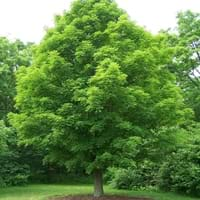Life Span
Perennial
Perennial
Origin
Not Available
North America, United States, Northeastern United States, Mid-Atlantic United States, Southeastern United States, North-Central United States, Central United States, South-Central United States, Canada
Types
Not Available
not available
Habitat
Forests, gardens, Hill prairies, Homesteads, Rocky areas, Woodlands
Forest edges, Open areas, Roadsides, wastelands
USDA Hardiness Zone
Not Available
4-8
AHS Heat Zone
Not Available
8-1
Sunset Zone
Not Available
1a, 1b, 2a, 2b, 3a, 3b, 4, 5, 6, 7, 8, 9, 14
Habit
Bushy, Evergreen
Oval or Rounded
Flower Color
Light Green, Lime Green
Chartreuse
Flower Color Modifier
Not Available
Bicolor
Fruit Color
Green, Light Green
Tan
Leaf Color in Spring
Yellow, Green, Gray Green
Green, Dark Green
Leaf Color in Summer
Light Green
Green, Dark Green
Leaf Color in Fall
Yellow, Green, Gray Green
Yellow, Red, Orange, Gold, Pink, Orange Red
Leaf Color in Winter
Yellow, Green, Gray Green
Not Available
Leaf Shape
Ovate
Maple shaped
Plant Season
Spring, Summer, Fall, Winter
Spring, Summer, Fall
Sunlight
Full Sun, Partial Sun, Partial shade
Full Sun, Partial Sun
Type of Soil
Loam, Sand
Clay, Loam, Sand
The pH of Soil
Acidic, Neutral, Alkaline
Acidic, Neutral
Soil Drainage
Well drained
Well drained
Bloom Time
Early Summer, Summer, Late Summer, Early Fall
Early Spring
Tolerances
Pollution, Salt, Soil Compaction
Not Available
Where to Plant?
Ground
Ground
How to Plant?
Seedlings, Stem Cutting, Stem Planting
Stem Planting
Plant Maintenance
Low
Medium
Watering Requirements
Keep ground moist, Requires regular watering, Use Mulches to help prevent water loss during hot and windy weather
Requires regular watering
In Summer
Lots of watering
Lots of watering
In Spring
Moderate
Moderate
In Winter
Average Water
Average Water
Soil pH
Acidic, Neutral, Alkaline
Acidic, Neutral
Soil Type
Loam, Sand
Clay, Loam, Sand
Soil Drainage Capacity
Well drained
Well drained
Sun Exposure
Full Sun, Partial Sun, Partial shade
Full Sun, Partial Sun
Pruning
Cut or pinch the stems, Do not prune during shooting season, Remove deadheads
Remove damaged leaves, Remove dead leaves
Fertilizers
High Potash Fertilizer
Doesn't require fertilization when grown in rich soil
Pests and Diseases
Bacterial Blight, Foliage-feeding caterpillars, Moth
Red blotch
Plant Tolerance
Pollution, Salt and Soil Compaction
Drought
Flowers
Showy
Insignificant
Flower Petal Number
Single
Not Available
Foliage Texture
Fine
Medium
Foliage Sheen
Matte
Matte
Attracts
Caterpillar
Not Available
Allergy
Skin irritation
Asthma
Aesthetic Uses
Not Used For Aesthetic Purpose
Showy Purposes
Beauty Benefits
Blood purifying, Glowing Skin, Good for skin and hair, Provides herbal hair care, Speed hair growth
Not Available
Environmental Uses
Air purification, soil stabilisation
Air purification
Medicinal Uses
Atherosclerosis, Cancer, Diabetes, Diarrhea, High blood pressure, High cholestrol, Obesity, Vitamin C
Cough, Diarrhea, Diuretic, Expectorant, Sore Eyes
Part of Plant Used
Fruits
Whole plant
Other Uses
Making Shampoo, Used for its medicinal properties, Used in herbal medicines
Edible syrup, Used as Ornamental plant
Used As Indoor Plant
No
No
Used As Outdoor Plant
Yes
Yes
Garden Design
Cottage garden
Feature Plant, Shade Trees
Botanical Name
Phyllanthus emblica
ACER saccharum
Common Name
Indian Gooseberry, Amla , Awala
Sugar Maple
In German
Stachelbeere
Zuckerahorn
In French
Groseille à maquereau
sucre d'érable
In Spanish
Grosella
arce de azúcar
In Greek
Φραγκοστάφυλλο
Maple ζάχαρη
In Portuguese
Groselha
Bordo de Açucar
In Polish
Agrest
Cukier klonowy
In Latin
hominem
Sugar Maple
Phylum
Magnoliophyta
Magnoliophyta
Class
Magnoliopsida
Magnoliopsida
Order
Malpighiales
Sapindales
Family
Phyllanthaceae
Aceraceae
Clade
Angiosperms, Eudicots, Rosids
Angiosperms, Eudicots, Rosids
Tribe
Phyllantheae
Not Available
Subfamily
Not Available
Not Available
Number of Species
Not Available
Not Available
Importance of Indian Gooseberry and Sugar Maple
Want to have the most appropriate plant for your garden? You might want to know the importance of Indian Gooseberry and Sugar Maple. Basically, these two plants vary in many aspects. Compare Indian Gooseberry and Sugar Maple as they differ in many characteristics such as their life, care, benefits, facts, etc. Every gardener must at least have the slightest clue about the plants he wants to plant in his garden. Compare their benefits, which differ in many ways like facts and uses. The medicinal use of Indian Gooseberry is Atherosclerosis, Cancer, Diabetes, Diarrhea, High blood pressure, High cholestrol, Obesity and Vitamin C whereas of Sugar Maple is Cough, Diarrhea, Diuretic, Expectorant and Sore Eyes. Indian Gooseberry has beauty benefits as follows: Blood purifying, Glowing Skin, Good for skin and hair, Provides herbal hair care and Speed hair growth while Sugar Maple has beauty benefits as follows: Blood purifying, Glowing Skin, Good for skin and hair, Provides herbal hair care and Speed hair growth.
Compare Facts of Indian Gooseberry vs Sugar Maple
How to choose the best garden plant for your garden depending upon its facts? Here garden plant comparison will help you to solve this query. Compare the facts of Indian Gooseberry vs Sugar Maple and know which one to choose. As garden plants have benefits and other uses, allergy is also a major drawback of plants for some people. Allergic reactions of Indian Gooseberry are Skin irritation whereas of Sugar Maple have Asthma respectively. Having a fruit bearing plant in your garden can be a plus point of your garden. Indian Gooseberry has showy fruits and Sugar Maple has showy fruits. Also Indian Gooseberry is not flowering and Sugar Maple is not flowering . You can compare Indian Gooseberry and Sugar Maple facts and facts of other plants too.





